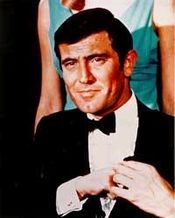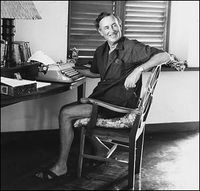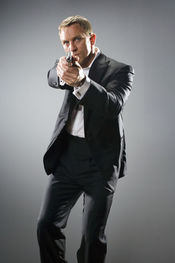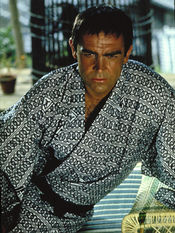James Bond (character)

The name's Bond... James Bond, an iconic character that has lit up the imaginations of young men for generations. With his Walther PPK, his Aston Martin DB5, and his Gillette razor, Bond has tackled evil villains and saved the world on 24 thrilling cinematic occasions (plus one unofficial one). He is a symbol of rugged masculinity, suave sophistication and British imperialism. This is a winning formula that should not be messed with.
Books
If James Bond is Jesus, then Ian Fleming is the bloke who wrote The Bible. Between 1953 and 1965, Fleming wrote fourteen books that would make up the Bond testament. It is from his sacred texts that we get M, Q, Moneypenny, and Nic Nac. His works were later parodied in the Monty Python film, The Life of Austin Powers.
In giving the world the gift of Bond, Fleming gave a part of himself. During the Second World War, Fleming worked for the British Intelligence Service, excelling within this shadowy world of secrets and spymastery. The young officer spent his time in intelligence headquarters dreaming up daring examples of British ingenuity and bravery. If jetpacks and poison-arrow-shooting watches had been invented by the 1940s, some of these plans would surely have been put into action.
After the war, Fleming went and worked for a newspaper. As he sat at his desk, reporting on the nation's fattest cats and longest-married couples, Fleming's mind would wander to his secret service past. This did have an effect on his work.
| “ | Pussy tucked into her fifth bowl of Whiskers that day. It sat there, having been lightly shaken into the bowl by Pussy's owner, Mrs Beswick, the spoon long since cast aside. Beswick knew the dangers that such a massive consumption of meaty chunks could bring for a cat, but she would not let these worries stand in the way. For she had her plan. Pussy was to be the biggest, most powerful feline in the world. | ” |
Eventually, someone suggested to Fleming that he write a spy novel. It turned out that he was a natural at it. Every year, Fleming would travel to his Goldeneye resort in Jamaica. There, amongst the golden beaches and crystalline blue sea, Fleming would lock himself in an airless room with a typewriter, facing the wall. He was a bit weird, really. But Fleming was a genius nonetheless and his novels were exported from Jamaica faster than marijuana. It was only a matter of time before the books were turned into films.
The Men with the Licence to Kill

Some were old, some were young, some were funny, some were serious, some were English, some were Scottish. One of them was Welsh, which was just disgusting. While they have their differences, they all share a common love for killing people and forcing themselves upon women, and for that, we love them. They are our Bonds.
Sean Connery
Sean Connery wasn't just a Scottish milkman with a preponderance for overusing "sh" sounds. He wasn't just the first Bond. He was the Bond. The strategy of hiring an unknown, inexperienced actor who was able to take part in the film's daring stunts was a masterstroke. With his work on Dr. No, Connery redefined the role of 007, before anyone else had even had a go. He was cool, but he was also cold and cruel. Connery's Bond was a man you could believe in: tall, strong, handsome, and with a powerful sex appeal.
With the best Bond ever at the helm, the new series of Bond films was a magnificent success. Scores of eager fans would queue up at the overflowing cinemas to catch a glimpse of the dashing Scot's powerful sex appeal in such classics as Dr. No, Goldfinger, and Thunderball, all the while speculating on whether this Bond would go on to be the best of all time. They were right. He would be the best 007.
Connery brought a gritty realism to the role of Bond. There is a determination in his eyes that is always there, whether he is fighting SPECTRE, dodging poison tipped high heels, or protecting his money in a Caribbean tax haven.
Connery made six classic Bond films, before he was ridiculously cast aside for being too old. However, you can never keep a good 007 down. He would be back in an unofficial Bond film: Never Say Never Again. He may have been in his fifties, but age is irrelevant when you have the power and sex appeal of Connery. The film was a roaring, point-proving success and was by far the best unofficial Bond film ever made. Connery could have been Bond to this day, and the movies, despite his age, would have been the greatest ever.
George Lazenby

When the Bond producers made the heinous and misguided decision to replace Sean Connery with a younger actor in 1969's On Her Majesty's Secret Service, they committed the biggest, most sacrilegious error in Bond history. The man they hired in his place was a novice actor whose selection was based entirely on his looks and ability to perform stunts. It was madness.
George Lazenby appeared in only one Bond movie, which was a disaster. It made less money than Sean Connery's films, it was less popular with critics than Sean Connery's films and featured fewer images of Sean Connery than Sean Connery's films.
On Her Majesty's Secret Service featured many outrageous misjudgements, which mar the film and the series. Bond appears in a kilt (a slap in the face to the Scottish Connery), masquerades as a homosexual (a slap in the face to the powerfully heterosexual Connery) and breaks the fourth wall by talking to the audience (a slap in the face to Connery, who hated his fans). Perhaps worst of all, Lazenby utilises a huge and unwieldy safe-cracking device, which is far less advanced than one used in a previous Connery film. Are we supposed to believe technology went backwards in the intervening two years? The film is most remembered for the ending, where Bond marries his Bond girl, Tracy, who is then killed, presumably for having such a boring name. Bond cries over her dead body. In this moment, James Bond becomes a pussy.
Roger Moore
Before Sean Connery was offered the role of best Bond ever, Ian Fleming had recommended Roger Moore for the part. In many ways it was a blessing that Fleming did not live long enough to see himself proved so utterly wrong.
Under Moore's stewardship the Bond franchise became one big joke. Ridiculously smutty names (Dr Holly Goodhead, Mary Goodnight, Lady Bettie Greatlay, Jane Swallowspunk), ridiculously over the top henchmen and Grace Jones all blighted the era. With quips and double entendres, Moore brought a tongue-in-cheek approach to a firmly tongue-out-of-cheek role. This comedy was taken to its extreme when Bond dressed up as a clown to sneak into a circus in Octopussy. The "Twenty Bonds tumble out of an Aston Martin" scene was cut from the final production.
Despite his many glaring flaws and cringe-inducing innuendos, Moore "kept the British end up" as Bond in seven films. Seven! That's more than Connery! Moore didn't do a decent one after his third, yet they let him do four more! By the time Moore starred in his final 007 adventure, however, he was almost sixty years old and could keep the British end up no longer. With "0070", it was less A View to a Kill and more A Squint at a Slow Descent Into Senility.
However, do note that James Bond is meant to be a posh, upperclass Englishman...ENGLISH, not Scottish, Irish or Jamaican. So unfortunately, Moore is the only real bond.
Timothy Dalton
When Timothy Dalton became the fourth man to play Bond, he brought in a much grittier, darker interpretation of the secret agent. He was dull. Where had the humour gone? Where were the witty asides that could charm the pants off (a then still unfortunately male) M? With Dalton as leading man there was a 63% decrease in double entendres and a 39% increase in nerdy superfluous detail.
Dalton's Bond was also a coward, as evidenced by the start of The Living Daylights, where he refuses to shoot a female hitman hitperson assassin. In fact, the most memorable scene of the film features him sliding downhill on a cello; sliding away from the bad guys. Real men use cars. Furthermore, Dalton's Bond was unpatriotic. In Licence To Kill he leaves the secret service to embark on a revenge mission, abandoning his responsibility to his country in a manner Bond never would. He didn't have a Union Jack parachute either.
Dalton's entire persona was an abject failure. Where once Bond had made a witty aside, played a hand of baccarat and proceeded to calmly shoot dead a supervillain with his silenced Walther PPK, Dalton's Bond grunted, put some money on the pools, and clubbed a henchman from behind with a sock full of coins.
Dalton was contracted to do three films, but various legal disputes held up filming after the second was released. After five years of the Hollywood equivalent of turning off the lights and hiding behind the sofa until your boring relatives go away, Dalton finally got the hint and quit the role.
Pierce Brosnan

When James Bond stepped back onto our screens in 1995, he returned to a different world. The Cold War had ended and we were now friends with the Russians. So who was Bond going to kill? The answer to that question is (Russian) petty criminals and media tycoons. While it was nice to see Bond slap around Rupert Murdoch, it lacked the epic history-making spectacle of the Connery past. By the time attentions were turned to North Korea, it was too late. One can only hope that Russian president, Dmitry Medvedev, continues his efforts to renew hostilities with the West.
The Bond of the 1990s was also different. He was Irish. Pierce Brosnan, who had previously found fame in Mrs. Doubtfire, became the fifth man to play 007. His Bond lacked the serious grittiness that the role required, replacing it with gadgets, lots of gadgets. Brosnan's O'Bond used an exploding pen, an invisible car, a virtual reality fighting simulator and CGI to help him save the world. Over the course of Brosnan's four films, Q branch worked overtime, so much so that they had to bring in the disastrously miscast John Cleese as R to help. Not only did Cleese get the better of Bond verbally, but, by having Cleese stand next to a man in a dinner suit, Bond was turned into Manuel from Fawlty Towers. Sean Connery's Bond would never have stood for such treatment. Sean Connery's Bond would have slapped Cleese across the mouth and then had sex with someone's granddaughter.
Daniel Craig
Take a look up the page and study the pictures. Now look to the left. Doesn't look much like James Bond does he? With his blond hair and blue eyes, Daniel Craig is more Barbie than Bond. Cubby Broccoli would have kicked him out of the audition room before he'd said a word. He knew that a blond playing Bond would be as ridiculous as a thin man playing Henry VIII or a northerner playing Doctor Who.
The most famous scene from Craig's first film, Casino Royale, shows him strutting out of the ocean modelling tiny swimming trunks, like a tart. By parading himself in such a way, Craig has become the first Bond boy. This is meant to be some kind of post-modern irony. All it does is make his Bond into a bit of a girl. While all the ladies, who find Bond too violent, gush over his abs and rock hard pecs, the real Bond fans know that this is not the body of a 007. Britain's finest spy should have a powerful, burly physique, with a small forest of hair on his chest. Bond should look like he got his body from wrestling metal-jawed giants in the daytime and then wrestling women into his bedroom in the evening. Craig looks like he got his body from lifting weights, probably whilst wearing a leotard in his local LA Fitness, next door to the waxing salon.
Bond music
There is only one way to make a Bond theme. The atmospheric brass, the stirring strings, the big, bombastic voice of a Jones or Sinatra. All these are essential music-making kit for a 007. Sadly, there hasn't been a decent James Bond theme since Carly Simon sang "Nobody does it better" for The Spy Who Loved Me.
It should be easy to create a stylish, glitzy, show song, that is new and refreshing, but also exactly mirrors the classics of Bond's 1960s prime. Yet, somehow, Duran Duran, Garbage and Jack White have all failed to emulate Shirley Bassey. Worst of all was Madonna's tinny, tuneless and tinnitus-inducing theme for Die Another Day. The last thing Bond needed was a gyrating grandmother waggling her vagina across the official Bond soundtrack. We'd already had Roger Moore.
Highlights of Bond's cinematic legacy
- Bond converts a lesbian. Her name was Pussy Galore, the trusted pilot of nefarious villain, Goldfinger. For once, Bond had found a woman immune to his subtle charms. Or so she thought. While Pussy claimed to prefer her namesake, Bond knew she'd be no match for his sophisticated seduction technique: force. Lesbian or not, no woman could resist James's cheeky pin-her-down-in-a-barn-and-ignore-her-screams manoeuvre. They taught that at Eton.
- A master of disguise. Having faked his own death at the start of You Only Live Twice, Bond needed to take on an elaborate disguise to mask his second life. His cohort, Tanaka, suggested he could become an authentic Japanese fisherman. So, in between training with the elite ninjas of Japan's secret service, Bond underwent a complex skin pigmentation procedure and was given a new wig. The transformation was complete when Japan's finest scantily-clad cosmetic technicians gave him authentic slitty eyes by way of hand crafted implant. Bond looked a completely new man. To celebrate this, he took part in a traditional Japanese marriage ceremony, the purpose of which one needs expert knowledge of modern espionage to fully comprehend.
- Dripping Honey. In Doctor No, the first Bond girl, Honey Ryder, made an entrance from the sea that no man or bikini salesperson would ever forget. Singing a delightful song about mango trees, she was there to collect sea shells by the sea shore. But her role wasn't just to mock Connery's troubles with the letter "s," this lady could look after herself too. Her bikini came with a knife.
- Shark! Thunderball's villainous protagonist, Largo, not only set new standards for the stylish use of eye patches, he also was an innovative trend-setter in creative murder. Locking Bond and an expendable guard in a swimming pool which was soon to be home to a swarm of hungry sharks, was a beautiful example of the art of the kill. Bond had nowhere to go. That is apart from going through the entrance the sharks were coming down. With his impossibly tiny breathing apparatus, Bond managed to reach the sharks' stylishly unattended home enclosure and walk free. Largo's plan may have failed on this occasion, but his ingenuity would inspire unlucky supervillains for decades to come.
These are just the tip of the iceberg amongst many moments that will live long in the memory of devoted fans worldwide. They may never be surpassed, but as long as James Bond is still indisputably better than Jason Bourne, E-ON films will continue producing the best series of films ever conceived.






